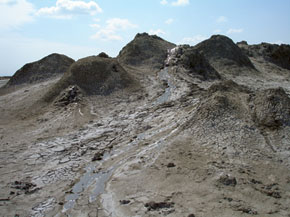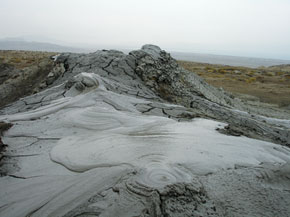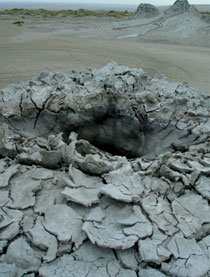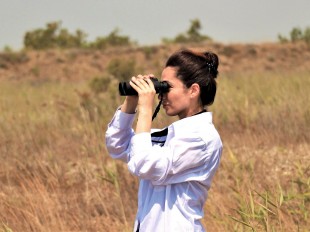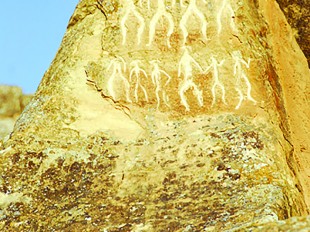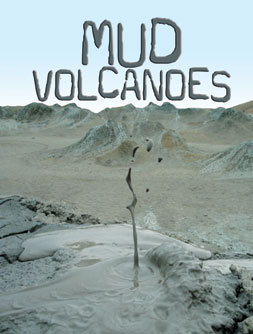 Pages 38-42
Pages 38-42by Shirin Manafov
Absheron is truly unique for its mud volcanoes. There are 300 of them in Azerbaijan, or 30 per cent of the world’s total.
The Bogboga mud volcano on the Absheron peninsula represents an underground laboratory in which oil is produced. This was the opinion of late 19th century geologists. Indeed, a mud volcano is an unmistakable sign of the presence of oil and gas beneath the surface. Foreign oil industry specialists and geologists working on Absheron often visit the fields where the world’s first oil was produced. According to Adil Aliyev, Doctor of Geology and Mineralogy and Director of the Mud Volcanoes Laboratory under the Institute of Geological Scientific Research, a tourist route to such phenomena should have been established long ago, especially as they are all located on Absheron.
Professor Aliyev says:
Mud volcanoes are particularly diverse in Azerbaijan. There are giant volcanoes, such as Toragay and Great Kanizdag in Gobustan, Otmanbozdag and Bozdag-Guzdek on Absheron, with a total elevation of 400 metres. Volcanoes are also registered on islands in the Baku archipelago. Eight of these islands, including Khara-Zira, Zenbil and Garasu, are volcanic. There is a volcano called Goturdag, which is the world’s only continuously erupting volcano; mud squeezing as the specialists put it, has been observed there for many years. There are volcanoes on the coast of the Caspian: Bandovan, Hamamdag and Bahar. I often travel to the sites of mud volcanoes with specialists from oil companies and scientists from Europe and America. They are all very pleased to go, because mud volcanoes are very informative for geologists and experts in the transportation of oil and gas.
The Bandovan volcano is particularly interesting. There was a city at its foot in the Middle Ages. Archaeologists have discovered the remains of dwellings, ceramic crockery and tools only 100-200 metres from the sea. This coastal city may have been destroyed not only by the rising level of the Caspian, but also by volcanic eruption. It is possible that Bandovan was the Etna of Absheron, while the flooded city at its foot was the Caspian Pompeii.
In 2002, a construction company suggested building a Disneyland on Bula Island. The idea caused some interest, but a year later a long-dormant volcano erupted there. In fact, any island in the Baku archipelago could throw up a surprise or two. The most interesting routes and sites for geologists, seismologists, geographers, oil workers, construction specialists and, of course, students of construction and oil companies are the mud volcanoes around Baku. Following the recent powerful earthquake in Japan, Absheron has become a focus of attention for designers of nuclear power stations. The mud volcanoes are especially useful because they often serve as indicators of seismic activity in the coastal area and the Caspian region as a whole. A number of them are very active, and provide companies designing oil pipelines with valuable information about the situation in the Caspian region Absheron is important in this respect as there are over 300 mud volcanoes on the islands of the Baku archipelago and in the coastal zone.
Mud volcanoes are also of great interest to those fond of nature. Back in the 1990s, Professor Aliyev suggested to the administration of the Gobustan reserve that the near-by Dashgil volcano, one of the biggest and most active in the country, be included on a tourist trail to the reserve. The volcano is so popular that employees of oil companies operating in Baku take their colleagues and visitors there on a regular basis.
Land of mud volcanoes
There are 850 mud volcanoes in the world, and over 300 of them are in Azerbaijan. Our country is a world leader, not only for the number but also for the activity of its volcanoes. Most are located on Absheron, around Baku. There are 100 near the Gobustan reserve alone. There are another 200 on the islands of the Baku archipelago and in Shamakha and Shirvan Districts, two hours’ drive from Baku. There are far fewer mud volcanoes in Iran and Turkmenistan; they are also found in Pakistan, Ukraine, Columbia, Trinidad, Romania, Burma, Malaysia etc.
Azerbaijan is also unique because it has all kinds of mud volcano, making it possible to study various aspects of mud eruptions. There are active, dormant, buried and subsea volcanoes in Azerbaijan, as well as those on islands and spewing oil. For instance, there are many subsea mud volcanoes around the Baku archipelago. The Goturdag volcano in Gobustan is the only mud volcano of its kind – it has been issuing mud for 100 years.
Geologists and petroleum specialists see a mud volcano as a free exploratory drilling rig. The value of such a rig is in the fact that may go down 12 km. Like any super-deep well, a mud volcano provides geologists with a plethora of information about the processes taking place at a depth of 10-12 km. Volcanic mud contains valuable microelements such as vanadium, manganese, lithium, boron etc. Erupted water is rich in organic compounds, as well as in bromide, boron and iodine. This is one of the reasons why volcanic mud is extensively used in cosmetology. Research conducted by Azerbaijani scientists under Professor Aliyev’s leadership have established that volcanic clay is a valuable raw material for use in the production of high-quality cement, expanded clay, bricks and steel pellets. It is used extensively in construction. Breccia, another product of eruption, contains a number of valuable chemicals that are easy to extract.
The volcano awakes
Every awakening of a mud volcano presents science with revelations. There are three to five eruptions in Azerbaijan every year, more in active periods. In 2004, for instance, there were seven eruptions in Azerbaijan. A record of 16 eruptions was registered in 2001. According to Professor Aliyev, over 350 eruptions were registered of 87 mud volcanoes in Azerbaijan between 1810 and 2006. Fortunately, such eruptions are much “humbler” than those of Krakatoa of Icelandic volcanoes.
While standing near a volcano, one can hear an underground rumble, a shaking of the earth, a roaring, as if after an explosion. It is also possible to see the emission of breccia and the spontaneous combustion of methane gas, accompanied by a fiery column 200 to 500 metres high. The spectacle is quite impressive, but it is not a good idea to come too close, because the temperature at the epicentre may range from 1,000 to a fantastic 12,000 degrees Centigrade. Breccia comes out of the volcanic crater and the lava flows down its slopes in fiery red streams. Even more impressive are eruptions of offshore mud volcanoes. Those who have seen one are sure to remember it. A water fountain spurts into the air out of a calm sea and this is followed by a fiery column. The fountain doesn’t last long, because it takes huge energy to cut through the water column. The latest such phenomenon resulted in the immediate appearance of a new island in the Caspian. Sometimes the island rises more than two metres above sea level. Such islands don’t usually last long, as the Caspian waters wash them out, turning them into a submerged shoal. This is exactly what happened in 1958, when a volcano erupted in the evening; during the following day the island that had emerged sank to become a submerged shoal. The Buzovna volcano has twice created new islands, in 1953 and 2001, and both times the islands lasted no longer than one day. However, there are other possibilities in the Caspian, such as at the Yanan Tava sandbank in the Baku archipelago, which was considered an island for 40 years until it was swallowed by the sea.
Every mud volcano is important to science, but the record-breakers catch the eye. For instance, the Cheildag eruption of 1970 lasted over a month, while hydrocarbon gas emissions from the crater continued for another three months. Another Cheildag eruption was registered quite recently, in 2004, but its potential is not exhausted yet and it is expected to produce many more surprises.
One of the world’s most interesting mud volcanoes is Goturdag, not far from Baku. As mentioned above, it has been erupting continuously for 100 years. The mouth of the volcano, 50 metres long and 15 metres wide, spews semidry breccias, like paste from a tube, as Professor Aliyev describes it. The ‘paste’ squeezed from the volcano peaked at 42 metres a year in 1926.
Thanks to many years of research of such a large number of on- and offshore volcanoes, Azerbaijani vulcanologists have contributed much to global science. In particular, convincing evidence has been obtained from the Caspian that earthquakes spark off significant mud volcano activity, acting as a trigger for volcanic eruptions. According to Professor Aliyev, this connection is observed when the epicentre of an earthquake and a mud volcano are located in the same fault zone and the volcano has been dormant for many years, accumulating enough energy to ‘blow’. The eruption usually takes place shortly after an earthquake. The Shikhzairli volcano near Shamakhi and the Marazi settlement went off 15 minutes after a powerful earthquake in Shamakhi in 1902. The record number of 16 eruptions was registered in 2001 in the aftermath of earthquakes registering 6 -7 points in the Caspian on 25 November and 6 December 2000.
Volcanic healing
There are plans to establish a mud sanatorium on Absheron in view of the abundance of the material. Thanks to its efficacy in balneal therapy, volcanic mud is used in the treatment of disorders of the central and peripheral nervous system, diseases of the skin and digestive tract, gynaecology and cosmetology.
Back in the late 1970s, Professor Aliyev and Doctor of Medical Sciences Farida Efendiyeva, from the Institute of Balneology, conducted research which proved the high medical effectiveness of Absheron mud volcanoes. The methodology was introduced and used successfully at a number of hospitals in Baku and Absheron.
The Akhtala sanatorium was built in Georgia in the Soviet era although Georgia has only 10 mud volcanoes. Akhtala earned tremendous popularity throughout the USSR, specifically due to the application of volcanic mud in the treatment of various diseases. Azerbaijani volcanic mud is of better quality and more medically efficient.
Here is the opinion of Doctor of History Tufan Akhundov: “The trails proposed by vulcanologist Aliyev are also interesting because they pass through areas of Absheron rich in historical and archaeological monuments. For example, there is a map of the starry heavens on a plateau between the Nardaran and Bilgah settlements. Ancient astronomers used a flat rock to depict Ursa Major, Cassiopeia and the Pole Star. The stars were marked by small dents 30 cm deep and 20 cm in diameter. The map is believed to have been made in the third or second millennia BC. People call the place Muselallah Yeri, or a place where a rain ritual is performed. Not far from the fire-worshippers’ temple of Ateshgah there is the so-called Moshi Hamami, i.e. mud baths with their own hydro-sulphuric spring, used for healing purposes for over 150 years. This popular place is idea for the construction of a mud sanatorium.
There are epigraphic rock inscriptions near the Surakhani settlement, while the Upper Palaeolithic dwelling discovered on the outskirts of the settlement is the oldest of those discovered on Absheron. There is a medieval tower attributed to the 11-14th centuries near oil storage between Balakhani and Sabunchu. Gala village, with its interesting ethnographic museum, should also be included on the trail. This combination of environmental phenomena and historical monuments on one trail is quite rare and it would be irrational not to take advantage of it. It is certainly worth incorporating a tour of the Baku archipelago islands. Tourists can see the unique mud volcanoes on Zembil and other islands just 10-15 km from Baku.
